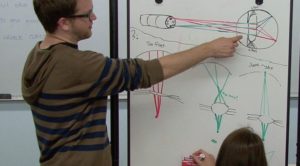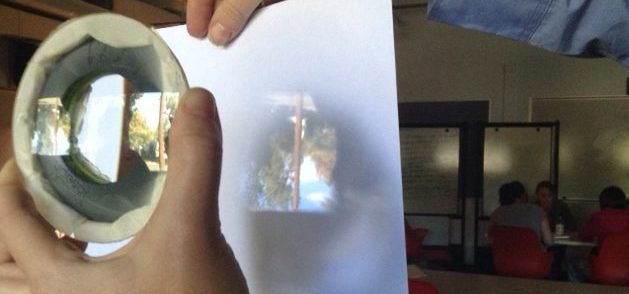 “Emphasizing informal writing practices in a classroom, rather than the formal, final products, may be a stronger approach to engaging students in scientific inquiry and scientific writing. Are groups of students discussing ideas, pen in hand, gesturing at the board, erasing and revising throughout their discussions? If not, it’s hard to imagine that much science is getting done, regardless of how much their term papers adopt the characteristics of scientific articles. If, however, you look into a classroom and see students clustered around a whiteboard, arguing over a representation as they move back and forth between empirical work, representations, and the model they are refining, then it is reasonable to assume that the substance of their work and the final products of their inquiry will be richly scientific.” –Chapter 2, Composing Science
“Emphasizing informal writing practices in a classroom, rather than the formal, final products, may be a stronger approach to engaging students in scientific inquiry and scientific writing. Are groups of students discussing ideas, pen in hand, gesturing at the board, erasing and revising throughout their discussions? If not, it’s hard to imagine that much science is getting done, regardless of how much their term papers adopt the characteristics of scientific articles. If, however, you look into a classroom and see students clustered around a whiteboard, arguing over a representation as they move back and forth between empirical work, representations, and the model they are refining, then it is reasonable to assume that the substance of their work and the final products of their inquiry will be richly scientific.” –Chapter 2, Composing Science
Click here for lesson plan: “The Masterclass: Learning to Give & Receive Critique”
Take-Home Messages for “Creating and Sharing a Whiteboard”
- Whiteboards play an indispensable role in scientific research as a place to develop ideas with colleagues and to make that development visible as newcomers are apprenticed into the lab. Whiteboards can serve
a similar role in the inquiry classroom: a semipublic, shared space where students work together to construct, share, and refine ideas, and witness how ideas are developed. - This informal writing often is overlooked as a form of scientific writing, but it is exactly the kind of writing that “writing across the discipline” programs seek to encourage: specific and central to the discipline,
and used in a way in which practitioners themselves “write to learn.” Moreover, such writing cannot be taught in a generic “freshman comp” course, but instead should be featured in science content classes as students develop scientific ideas. - Students are accustomed to the whiteboard as “belonging” to the teacher and as a space for right answers instead of drafts of ideas. They often will need support in using their whiteboards in a more informal and student-centered way to share tentative ideas that others are welcome to challenge.
- Instructors can model how to critique and co-construct ideas using a whiteboard. This may happen informally, as students present, or more formally through role-play in which the instructors position themselves as students working through a diagram, or through a “master class”in which an instructor and student critique and improve a diagram together as the rest of the class watches.
- In the classroom, whiteboards also can take the role of a conference poster. That is, they can be a place to share a group’s consensus ideas with a larger scientific community for discussion and feedback.
- If your students still struggle to use the boards productively, reconsider the kinds of models they are engaged in producing: Students should be genuinely interested in the questions and phenomena they are working with, and should have ownership over the direction that this inquiry will take.
- Whiteboards are used to receive formative assessment and feedback from peers and faculty. We rarely provide written, summative feedback on posters; in-class interactions with peers and faculty are generally sufficient. We have opted not to grade this form of writing, although students are encouraged to discuss it in their portfolios and it is essential that they incorporate the ideas from whiteboards into more formal work.
